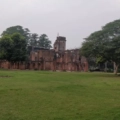Founded in the 16th century by Emperor Sikandar Lodhi (of the Lodhi dynasty), Agra is synonymous with fine Persian architecture. For instance, the concept of square gardens is a very prominent Persian influence evident in many of the monuments scattered in and around Agra.
Later on, the Mughals played a crucial role in shaping the city culturally and architecturally. Agra remained their capital from the mid-16th to the mid-17th century. However, it was during Shah Jahan’s reign when it reached its peak, and the Taj Mahal manifested!
However, the city has changed many hands throughout its history. It is believed to predate even the Mahabharat period. Within the recorded history, it was ruled by the Lodhi dynasty, the Mughals, the Rajputs, the Marathas, and the British. Each adding their distinctive touch to its ever-changing topography.
Although the Taj Mahal and Fatehpur Sikri are magnets for tourists, and for good reasons, those looking to find the hidden gems of Agara or something offbeat and away from the crowds, below is a introductory list to get you started.
Tomb of Akbar, Sikandra
Predating the Taj Mahal, this complex was commissioned by Emperor Akbar himself and was completed by his son Emperor Jehangir in 1613, after his father’s death.
Located about 13kms from Agra, it is an imposing structure made from red sandstone and marble, complete with intricate calligraphy and inlay work.
A vast Persian styled garden wraps the central tomb where antelopes and peacocks roam free, reminiscent of its ancient royal splendor. The design is a testimony to the secular governance pioneered by Emperor Akbar.
Influences from traditional Hindu, Persian and Christian styles can be prominently seen here. The south gate (also the main entrance) is a sight to behold with its beautiful floral, geometric, and abstract patterns.
Roman Catholic Cemetery
Contrary to our idea of a cemetery being cold and scary, this 400-year old Catholic Cemetery located in the Civil Lines is almost like a museum. Dotted with tombs that in themselves are an example of classic architectural gems, its one of the best kept secrets of Agra. These tombs belong to European soldiers, Armenian merchants, and Mughal subjects who served the empire in various capacities.
The highlight for visitors here, however, remains the Red Taj built entirely in red sandstone. While the design is fascinating and at par with the Taj Mahal, albeit much smaller in scale and showmanship, the story behind it is poignant.
Contrary to the Taj Mahal, this one was built by a grieving wife in memory of her husband, a Dutch soldier who died fighting the British. The only things missing in this tomb of Col John William Hessing are the four minarets like the Taj Mahal. It is said that his wife ran out of money, and hence they had to be removed from the original plan.
Tomb of Itimad-ud-Daula
With the Taj Mahal being an iconic symbol of Agra, many other monuments here are oft up against it. The tomb of Itimad-ud-Daula is one such masterpiece, which is popularly known as the ‘Little Taj.’ In all fairness, though, given its workmanship, it should be appreciated in its own right.
Commissioned during the reign of Emperor Jahangir by Empress Nur Jahan for her father, Itimad-Ud-Daulah, and completed around 1688, it is at once a symbol of her parental devotion and her power.
The intricate marble inlay work is a fine example of Mughal craftmanship immortalizing not only the deceased but also the times.
Akbar’s Church
Bearing the name of the greatest Mughal emperor is one of the earliest churches to be built in North India! Emperor Akbar’s curiosity about different religions, his openness to their ideologies, and his secular beliefs led him to interact with people of other faiths.
It is said that with some influence of a Jesuit missionary from Goa and a thriving Armenian community in Agra, Emperor Akbar obliged them with land and generous donations for building this church.
Rebuilt a few times after, the current structure might not be as grand as the original. However, it holds the timeless aura of the emperor and hence is fondly called ‘Akbar’s Church.’
Agra Bear Sanctuary & Sur Sarovar Bird Sanctuary
Run jointly by the UP Forest Department and Wildlife SOS, this is one of the world’s largest Sloth Bear Rescue Facilities. The team here regularly monitors the health and behavior patterns of bears rescued and brought here from various parts of the sub-continent. It then gives them appropriate veterinary care.
As a visitor, you, therefore, have a chance for a unique behind the scene conservation and educational tour.
The sancturary’s location inside the Sur Sarovar Bird Sanctuary makes it a wonderful day out away from the city, not only for animal lovers but also for those seeking a different experience during their Agra stay.
During winter season (Oct. – March), the Keetham lake within the sanctuary becomes a magnet for migratory birds. The serenity of this place is said to have inspired the famous Bhakti poet Surdas!
Mehtab Bagh
Imagine viewing the Taj Mahal without the crowds and capturing that perfect shot of it in the golden light. The Mehtab Bagh provides you with such a setting, making it a true-blue hidden gem in Agra.
This crescent-shaped garden was built by Emperor Babur in the early 1500s and was later authenticated by Emperor Shah Jahan as an ideal viewing point from which to admire the Taj Mahal.
Just across the river from the mausoleum, today it is nowhere near the original gardens that once stood in its place, but the views it gives are probably still similar to what Emperor Shah Jahan was talking about.
From being an inspiration to a battleground, Agra has seen many saints, poets, merchants, missionaries, and emperors pass through its streets, each leaving an indelible mark on its character. One needs to only dive deeper to truly appreciate its essence and uncover the layers buried in the sands of time.
Photos: Author, Pixabay and Unsplash









1 Comment
100 Country Trek
Agra was a fantastic place. We should have stayed longer..